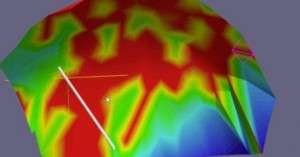Fibromyalgia

Definition
Fibromyalgia is a neurosensory disorder characterized by widespread muscle pain, joint stiffness, and fatigue. The condition is chronic (ongoing), but pain comes and goes and moves about the body. The disorder is often misdiagnosed or unrecognized and is and often complicated by mood and anxiety disorders.
Description
According to the American College of Rheumatology diagnosis criteria, fibromyalgia affects about 3-5% of women, most of whom are between ages 20 and 50, but only 0.5- 1.6% of men. Some experts feel the actual rate is much higher. Fibromyalgia is more prevalent in adults than children, with nine times more women affected than men. People with fibromyalgia are most likely to complain of three primary symptoms: muscle and joint pain, stiffness, and fatigue.
Causes and symptoms
At one time, fibromyalgia was thought of as a psychological disorder. Today, although the exact causes of fibromyalgia are not known, the disorder is believed to be caused by the interplay of biological, psychological, and sociocultural variables. Biological variables appear to be involved in the way the central nervous system (brain and spinal cord) process pain. People with the fibromyalgia appear to have a lower than normal threshold for perceiving and tolerating pain. Researchers have found that these people have more of an excitatory neurotransmitter called substance P in their spinal fluid. Substance P is involved in the transmitting and processing of pain signals to and from the brain. In addition, people with fibromyalgia seem to have low levels of the neurotransmitters serotonin and norepinephrine. The regulation of dopamine, another brain neurotransmitter, also appears to be faulty in people with fibromyalgia. Taken together, these abnormalities appear to lower the threshold at which the individual feels and tolerates pain. The tendency toward developing fibromyalgia is thought to have a genetic component. Individuals who have a close family member with the disorder are more likely to develop it themselves. Interestingly, physical trauma (e.g., automobile accident), which was once thought to be a trigger for fibromyalgia has been definitively shown not to initiate the disorder.
Psychological factors also affect the development of fibromyalgia. Emotional stress appears to be a trigger for the development of fibromyalgia in a person who is already biologically at risk. In addition, many people diagnosed with fibromyalgia have psychiatric mood disorders (e.g., depression bipolar disorder), anxiety disorders (e.g., generalized anxiety disorder, obsessive-compulsive disorder, panic disorder, posttraumatic stress disorder, social phobia) or eating disorders (e.g. anorexia nervosa). Interestingly, depression, and anxiety disorder have been linked to abnormalities in some of the same neurotransmitters that are thought to be involved in pain perception (e.g., serotonin, norepinephrine, dopamine).
Sociocultural factors are factors that affect the way an individual copes with pain. The ability to cope with pain may be influenced by events in childhood such as child abuse or living with a parent who coped poorly with chronic pain. Other sociocultural factors include the degree to which it is socially acceptable to express pain, whether family members encourage or discourage the individual to push past pain, and whether there is some benefit to the individual for being disabled by pain (e.g., monetary disability payments, attention from family members, successful litigation from an accident.)
Pain is the major symptom of fibromyalgia, with aches, tenderness, and stiffness of multiple muscles, joints, and soft tissues. The pain also tends to move from one part of the body to another. Although the pain is present most of the time and may last for years, the severity of the pain changes and is dependent on individual patient perception.
Symptoms of fatigue may result from the individual’s chronic pain coupled with anxiety about the problem. Almost all individuals with fibromyalgia complain of difficult sleeping or sleep that is not restful. Other common symptoms are tension headaches, recurrent abdominal pain, irritable bowel syndrome, numbness or tingling of the extremities, and problems with memory. Stress, anxiety, depression, and lack of sleep can increase symptoms. Intensity of symptoms is variable ranging from gradual improvement to episodes of recurrent symptoms.
Diagnosis
There are no specific laboratory tests to diagnosis fibromyalgia. Diagnosis is difficult and frequently missed because symptoms are vague and generalized. Tests will be done to rule out other conditions with similar symptoms before a diagnosis is made. Coexisting disorders such as rheumatoid arthritis, systemic lupus erythematosus, or Lyme disease may further complicate the diagnostic process.
In 1990, the America College of Rheumatology developed standards for the diagnosis of fibromyalgia. According to these standards, a person can be diagnosed with fibromyalgia if he or she has widespread pain in combination with tenderness in at least 11 of the 18 sites known as trigger points. Trigger point sites include the base of the neck, along the backbone, in front of the hip and elbow, and at the rear of the knee and shoulder. These standards have been criticized by some physicians as being too narrow for use in clinical practice. As of 2009, standards for diagnosis were under review.
Treatment
There is no known cure for fibromyalgia; therefore, the goal of treatment is successful symptom management. Treatment usually requires a combination of pharmaceutical therapies, appropriate exercise, proper sleep hygiene, and good nutrition. As of early 2009, he only drug specifically approved for treatment of fibromyalgia by the United States Food and Drug Administration was pregabalin (Lyrica), an anticonvulsant whose mechanism of action in the treatment of fibromyalgia was not completely understood.
Antidepressant drugs that alter the levels of neurotransmitters in the brain help improve symptoms of pain and disrupted sleep in many people with fibromyalgia. There are several classes of antidepressants, each with its own benefits and side effects.
Selective serotonin reuptake inhibitors (SSRIs) such as fluoxetine (Prozac), paroxetine (Paxil), fluvoxamine (Lovox), citalopram (Celexa), escitalopram (Lexpro), and sertraline (Zoloft) increase levels of serotonin in the brain.
Selective serotonin/norepinephrine reuptake inhibitors (SNRIs) such as venlafaxine (Effexor), duloxetine (Cymbalta), and milnacipram (Savella) are quite similar to SSRIs and are often prescribed for individuals with depression who also have extreme fatigue or chronic pain or who do not respond to SSRIs.
Atypical antidepressants such as bupropion (Wellbutrin), nefazodone (Serzone), mitazapine (Remeron), and trazodone (Desyrel) have fewer sexual and gastrointestinal side effects. They may cause drowsiness and aid individuals with insomnia.
Tricyclic antidepressants (TCAs) were the first major class of antidepressant developed. In low doses, they often improve pain symptoms in people with fibromyalgia. They are less expensive than SSRIs but have more severe side effects, which may include persistent dry mouth, sedation, dizziness, and cardiac arrhythmias. TCAs include amitriptyline (Elavil), imipramine (Tofranil), doxepin (Sinequan), protriptyline (Vivactil), and trimipramine (Sumontil).
Other types of drugs used to treat specific symptoms include muscle relaxants, anticonvulsants, and short-term use of drugs to treat insomnia. Nonsteroidal anti-inflammatory drugs (NSAIDs) and opiod analgesics do not have much effect on fibromyalgia pain, and opioid drugs carry the risk of physical addiction. They are not often prescribed for fibromyalgia pain. Any disorders, such as rheumatoid arthritis, depression, anxiety, or chronic fatigue syndrome must be treated along with fibromyalgia symptoms.
Nonpharmaceutical treatments that may be helpful include heat and occasionally cold applications. A regular stretching program is often useful. Aerobic activities focusing on increasing the heart rate are the preferred forms of exercise over most other forms of exertion. Exercise programs need to include good warm-up and cool-down sessions, with special attention given to avoiding exercises causing joint pain. The diet should include a large variety of fruits and vegetables which provide the body with trace elements and minerals that are necessary for healthy muscles.
Cognitive-behavioral psychotherapy, which helps the individual change negative thoughts and behaviors about their disorder, can be quite helpful. Individuals who take charge of and try to work through their pain often have fewer and milder symptoms and a better quality of life than those who focus on their disability and discomfort.
Alternative treatment
Frustrated with the inability of conventional medicine to cure their pain, as many as 80% of individuals with fibromyalgia turn to alternative and complementary treatments to supplement conventional treatment. Common complementary therapies for fibromyalgia include:
acupuncture
biofeedback
chiropractic care
hypnosis
magnesium supplements
magnet therapy
massage therapy
s-adenosyl-L-methionine supplements
Evidence of effectiveness of these complementary treatments is either mixed or insufficient to draw any firm conclusions; they may help some people and not others, or their benefit may be purely psychological. Individuals using complementary therapies should tell their physician, as some of these therapies, especially herbal supplements, have the potential to negatively interact with conventional pharmaceuticals that may be prescribed.
Prognosis
Fibromyalgia is a chronic condition. Symptoms sometimes improve and at other times worsen, but they often continue and must be managed for years.
Prevention
There is no known way to prevent fibromyalgia. However, remaining as healthy as possible with a good diet, safe exercise, and adequate rest and stress reduction may decrease the likelihood that the disorder will be triggered.
Key Terms
Dopamine
A neurotransmitter and the precursor of norepinephrine.
Lyme disease
An acute recurrent inflammatory disease involving one or a few joints, believed to be transmitted by a tickborne virus. The condition was originally described in the community of Lyme, Connecticut, but has also been reported in other parts of the United States and other countries. Knees, other large joints are most commonly involved with local inflammation and swelling.
Neurotransmitter
A chemical in the brain that transmits messages between neurons, or nerve cells. Changes in the levels of certain neurotransmitters, such as serotonin, norepinephrine, and dopamine, are thought to be related to depression.
Norepinephrine
A hormone released by nerve cells and the adrenal medulla that causes constriction of blood vessels. Norepinephrine also functions as a neurotransmitter.
Rheumatoid arthritis
A disease characterized by inflammation and degeneration of connective tissue in multiple joints at a young age.
Serotonin
5-Hydroxytryptamine; a substance that occurs throughout the body with numerous effects including neurotransmission. Inadequate amounts of serotonin are implicated in some forms of depression.
Systemic lupus erythematosus (SLE)
A chronic, inflammatory, autoimmune disorder in which the individual’s immune system attacks, injures, and destroys the body’s own organs and tissues. It may affect many organ systems including the skin, joints, lungs, heart, and kidneys.
For Your Information
Resources
Books
Ostalecki, Sharon. Fibromyalgia: The Complete Guide from Medical Experts and Patients. Sudbury, MA: Jones and Bartlett Publishers, 2008.
Websites
“CAM and Fibromyalgia.” National Center for Complementary and Alternative Medicine. July 2008 [cited February 25, 2009]. http://nccam.nih.gov/health/pain/fibromyalgia.htm.
“Fibromyalgia.” MedlinePlus. February 18, 2009 [cited February 25, 2009]. http://www.nlm.nih.gov/medlineplus/fibromyalgia.html.
“What Is Fibromyalgia?” National Institute of Arthritis and Musculoskeletal and Skin Disease. February 10, 2009 [cited February 25, 2009]. http://www.niams.nih.gov/Health_Info/Fibromyalgia/fibromyalgia_ff.asp.
Organizations
American College of Rheumatology (ACR). 1800 Century Place, Ste 250, Atlanta, GA 30345-4300. Telephone: (404) 633-3777. Fax: (404) 633-1870. http://www.rheumatology.org/.
Fibromyalgia Network. PO Box 31750, Tucson, AZ 85751-1750. Telephone: (800) 853-292- or (520) 290-5508. Fax: (520) 290-5550. Email inquiry@fmnews.com http://www.fmnetnews.com.
National Fibromyalgia Foundation. 2121 S. Towne Centre Place, Suite 300; Anaheim, CA 92806. Telephone: (714) 921-0150. Fax: (714) 921-6920. http://www.fmaware.org/.
.
Fibromyalgia
Antidepressants
Chronic pain
Gale Encyclopedia of Medicine. Copyright 2008 The Gale Group, Inc. All rights reserved.
thefreedictionary.com/




